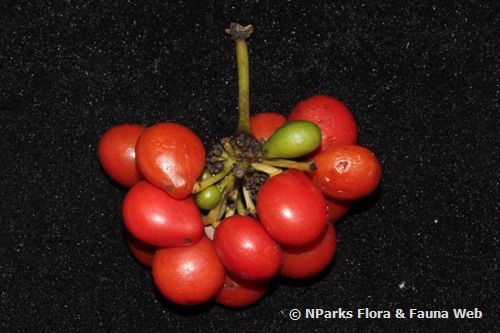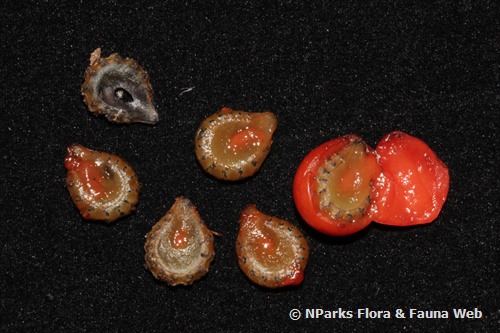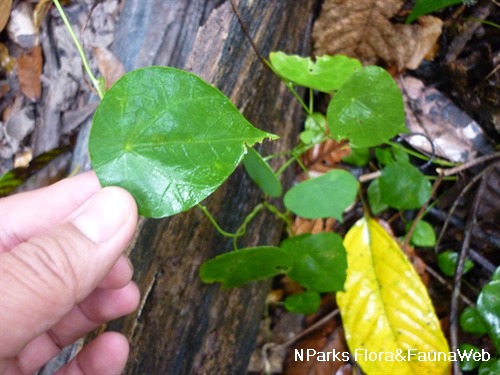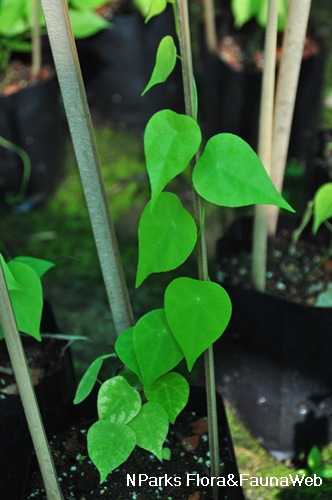
Name
Classifications and Characteristics
| Plant Division | Angiosperms (Flowering Seed Plants) (Dicotyledon) |
|---|---|
| Plant Growth Form | Climber |
| Lifespan (in Singapore) | Perennial |
| Mode of Nutrition | Autotrophic |
| Maximum Height | 15 m |
Biogeography
| Native Distribution | Thailand, Sumatra, Peninsular Malaysia, Singapore, Bali, Borneo, and Java |
|---|---|
| Native Habitat | Terrestrial (Primary Rainforest, Secondary Rainforest, Freshwater Swamp Forest, Grassland / Savannah/ Scrubland) |
| Preferred Climate Zone | Tropical |
| Local Conservation Status | Native to Singapore (Critically Endangered (CR)) |
Description and Ethnobotany
| Growth Form | It is a slender woody climber up to 15 m long, and not covered with hair. |
|---|---|
| Foliage | Its stalked leaves have papery blades that are lance-shaped to broadly egg-shaped, and 6–17 by 2.5–11 cm. |
| Flowers | Its flowers are yellow to green and have 2–3 sepals that are oblong-oval and 0.5–0.75 mm long. The flowers have 2–3 petals that are drop-shaped and 0.25 mm long. |
| Fruit | Its dry fruits are red, drop-shaped, and 8–11 by 6–8 mm. |
| Habitat | It grows scattered on plains, mountains, and in rainforests, from sea-level to 2000 m altitude. It occurs locally in Nee Soon Swamp Forest. |
| Associated Fauna | Its flowers are insect-pollinated. |
| Cultivation | It can be propagated by seed or stem cutting. |
| Etymology | Stephania, commemorating Frederick Stephan, once a professor at Moscow; Latin capitata, growing in the head, head-like, referring to the inflorescence or stigma |
| Ethnobotanical Uses | Food (Herb or Spice) Medicinal: Its leaves have been reported to be used in Java as a substitute for those of Cyclea barbata Miers to prepare ‘cincau’, which is used as a refreshment and as a medicine against stomach complaints. |
Landscaping Features
| Landscaping | It may be suitable for parks, on pergolas and trellises. |
|---|---|
| Landscape Uses | General, Parks & Gardens, Trellis / Arbour / Pergola |
Fauna, Pollination and Dispersal
| Pollination Method(s) | Biotic (Fauna) |
|---|---|
| Seed or Spore Dispersal | Biotic (Fauna) |
Plant Care and Propagation
| Light Preference | Full Sun, Semi-Shade |
|---|---|
| Water Preference | Moderate Water |
| Plant Growth Rate | Moderate |
| Rootzone Tolerance | Moist Soils, Well-Drained Soils, Fertile Loamy Soils |
| Propagation Method | Seed, Stem Cutting |
Foliar
| Foliage Retention | Evergreen |
|---|---|
| Mature Foliage Colour(s) | Green |
| Mature Foliage Texture(s) | Papery |
| Foliar Type | Simple / Unifoliate |
| Foliar Arrangement Along Stem | Alternate |
| Foliar Attachment to Stem | Petiolate |
| Foliar Shape(s) | Non-Palm Foliage (Ovate, Lanceolate) |
| Foliar Venation | Pinnate / Net |
| Foliar Margin | Entire |
| Foliar Apex - Tip | Acute |
| Foliar Base | Rounded / Obtuse |
Floral (Angiosperm)
| Flower & Plant Sexuality | Bisexual Flowers |
| Flower Colour(s) | Green, Yellow / Golden |
|---|---|
| Flower Grouping | Cluster / Inflorescence |
| Flower Location | Axillary |
Fruit, Seed and Spore
| Mature Fruit Colour(s) | Red |
|---|---|
| Fruit Classification | Simple Fruit |
| Fruit Type | Indehiscent Dry Fruit |
Image Repository
Others
| Master ID | 31690 |
|---|---|
| Species ID | 6089 |
| Flora Disclaimer | The information in this website has been compiled from reliable sources, such as reference works on medicinal plants. It is not a substitute for medical advice or treatment and NParks does not purport to provide any medical advice. Readers should always consult his/her physician before using or consuming a plant for medicinal purposes. |






